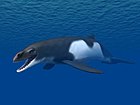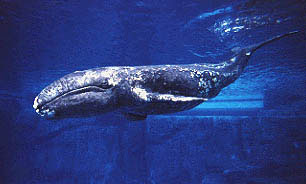
Eschrichtiidae or the gray whales is a family of baleen whale with a single extant species, the gray whale, as well as four described fossil genera: Archaeschrichtius (Miocene), Glaucobalaena and Eschrichtioides (Pliocene) from Italy, and Gricetoides from the Pliocene of North Carolina. Some phylogenetic studies have found this family to be invalid, with its members nesting inside of the clade Balaenopteridae. The names of the extant genus and the family honours Danish zoologist Daniel Eschricht.

Neobalaenidae is a family of baleen whales including the extant pygmy right whale. Although traditionally considered related to balaenids, recent studies by Fordyce and Marx (2013) and Ludovic Dutoit and colleagues (2023) have recovered the living pygmy right whale as a member of Cetotheriidae, making it the only extant cetotheriid. Not all authors agree with this placement.

Cetotherium is an extinct genus of baleen whales from the family Cetotheriidae.

Aetiocetus is a genus of extinct basal mysticete, or baleen whale that lived 33.9 to 23.03 million years ago, in the Oligocene in the North Pacific ocean, around Japan, Mexico, and Oregon, U.S. It was first described by Douglas Emlong in 1966 and currently contains known four species, A. cotylalveus, A. polydentatus, A. tomitai, and A. weltoni. These whales are remarkable for their retention of teeth and presence of nutrient foramina, indicating that they possessed baleen. Thus, Aetiocetus represents the transition from teeth to baleen in Oligocene mysticetes. Baleen is a highly derived character, or synapomorphy, of mysticetes, and is a keratinous structure that grows from the palate, or roof of the mouth, of the whale. The presence of baleen is inferred from the fossil record in the skull of Aetiocetus. Aetiocetus is known from both sides of the Pacific Ocean: it was first documented in Oregon, United States, but it is also known from Japan and Mexico. The genus is currently constrained to the Northern hemisphere and has little value in biostratigraphic studies of the Oligocene due to its limited occurrences across the Pacific.
Ashorocetus is a monotypic genus of an extinct primitive baleen whale of the family Aetiocetidae. It was named by Barnes et al. 1995, and contains one species, A. eguchii. Fossils of this whale are found from the Chattian Morawan formation, near Ashoro, of upper Oligocene Hokkaido, Japan. Ashorocetus eguchii was described based on a partial skull and is named after the type locality and Kenichiro Eguchi of the Ashoro Museum of Paleontology.

Cetotheriidae is a family of baleen whales. The family is known to have existed from the Late Oligocene to the Early Pleistocene before going extinct. Although some phylogenetic studies conducted by Fordyce & Marx 2013 recovered the living pygmy right whale as a member of Cetotheriidae, making the pygmy right whale the only living cetotheriid, other authors either dispute this placement or recover Neobalaenidae as a sister group to Cetotheriidae.

Parietobalaena is an extinct genus of baleen whale, belonging to the family Pelocetidae. Fossils are found in Miocene-aged marine strata in North America, Europe, Australia, and Japan, including the Temblor and Itahashi formations. Based on previous estimates of juvenile specimens, Tsai (2017) suggested a body size of 12-15 m for P. yamaokai, akin to that of the gray whale.
Plesiocetus is a genus of extinct rorquals found worldwide. It has had a chequered taxonomic history, having served as a wastebasket genus for a handful of mysticete species.
Peripolocetus is a genus of balaenid baleen whale from the middle Miocene of Kern County, California.
Eomysticetus is an extinct genus of baleen whale from the late Oligocene (Chattian) Chandler Bridge Formation of South Carolina.
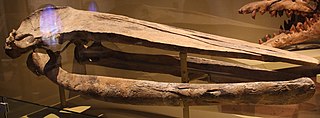
Aglaocetus is a genus of extinct baleen whales known from the Miocene of Patagonia, the US Eastern Seaboard, Japan and the Low Countries. It was once considered a member of Cetotheriidae along with many other putative cetotheres, but was recently recognized as representing a distinct family from true Cetotheriidae.
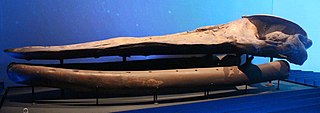
Mixocetus is a genus of extinct baleen whale belonging to the family Tranatocetidae. It is known only from the late Miocene (Tortonian) of Los Angeles County, California.
Nannocetus is an extinct baleen whale belonging to the family Cetotheriidae.
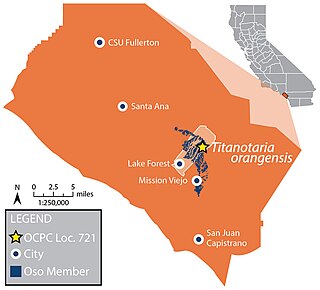
The Capistrano Formation is a geologic formation in coastal southern Orange County, California. It preserves fossils dating back to the late Miocene to early Pliocene, with the Oso Member representing a near-shore environment. Fifty-nine species and varieties of foraminifera are recognized from the Capistrano Formation alongside a diverse array of marine mammals including up to five species of walrus.
Mauicetus is a genus of extinct baleen whale from the Late Oligocene of New Zealand.
Eomysticetidae is a family of extinct mysticetes belonging to Chaeomysticeti. It is one of two families in the basal chaeomysticete clade Eomysticetoidea.

Tranatocetus is an extinct genus of mysticete from the late Miocene (Tortonian) of Jutland, Denmark. The type and only species is Tranatocetus argillarius.

Aetiocetidae is an extinct family of toothed baleen whales known from the Oligocene and latest Eocene, so far only from rocks deposited in the North Pacific Ocean. The whales ranged in size from 3 to 8 metres long. Many of the described specimens were discovered from the Upper Oligocene of the Japanese Morawan Formation, the largest known one from the Morawan's Upper tuffaceous siltstone. Other formally described extinct toothed mysticetis from this time are smaller, from 3 to 4 metres in length. Mysticeti with true baleen are seen in fossils from the Upper Oligocene. The monophyly of the family is still uncertain, as are the evolutionary relationship between the early toothed baleen whales and the early and extant edentulous baleen whales. However, the cladistic analyses of Coronodon and Mystacodon seem to indicate that Aetiocetidae and Llanocetidae are more closely related to crown Mysticeti than to Mammalodontidae, Coronodon, and Mystacodon.
Fucaia is an extinct genus of primitive baleen whale belonging to the family Aetiocetidae that is known from Oligocene and latest Eocene marine deposits on Vancouver Island, Canada, the Olympic Peninsula, Washington State, and Oregon.













